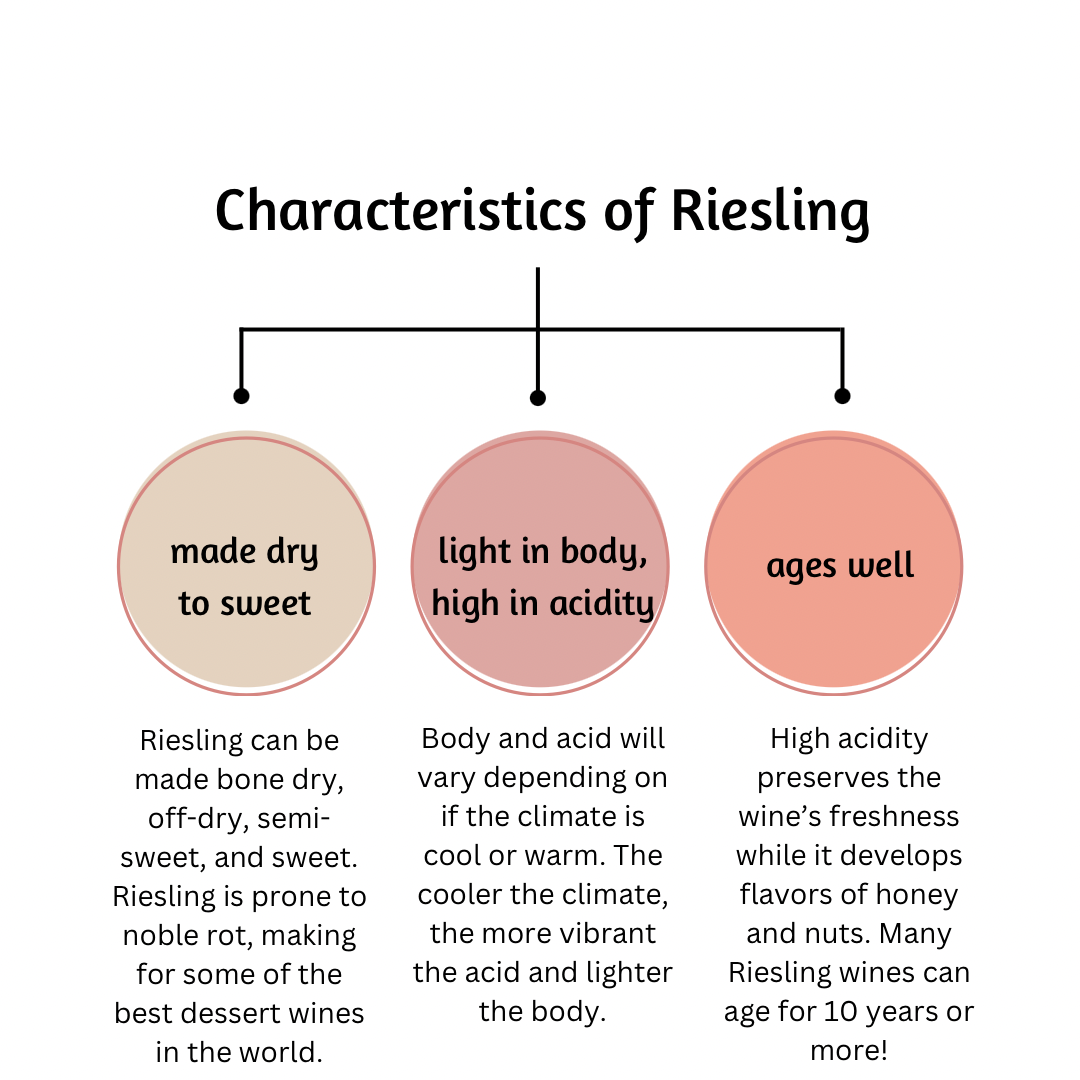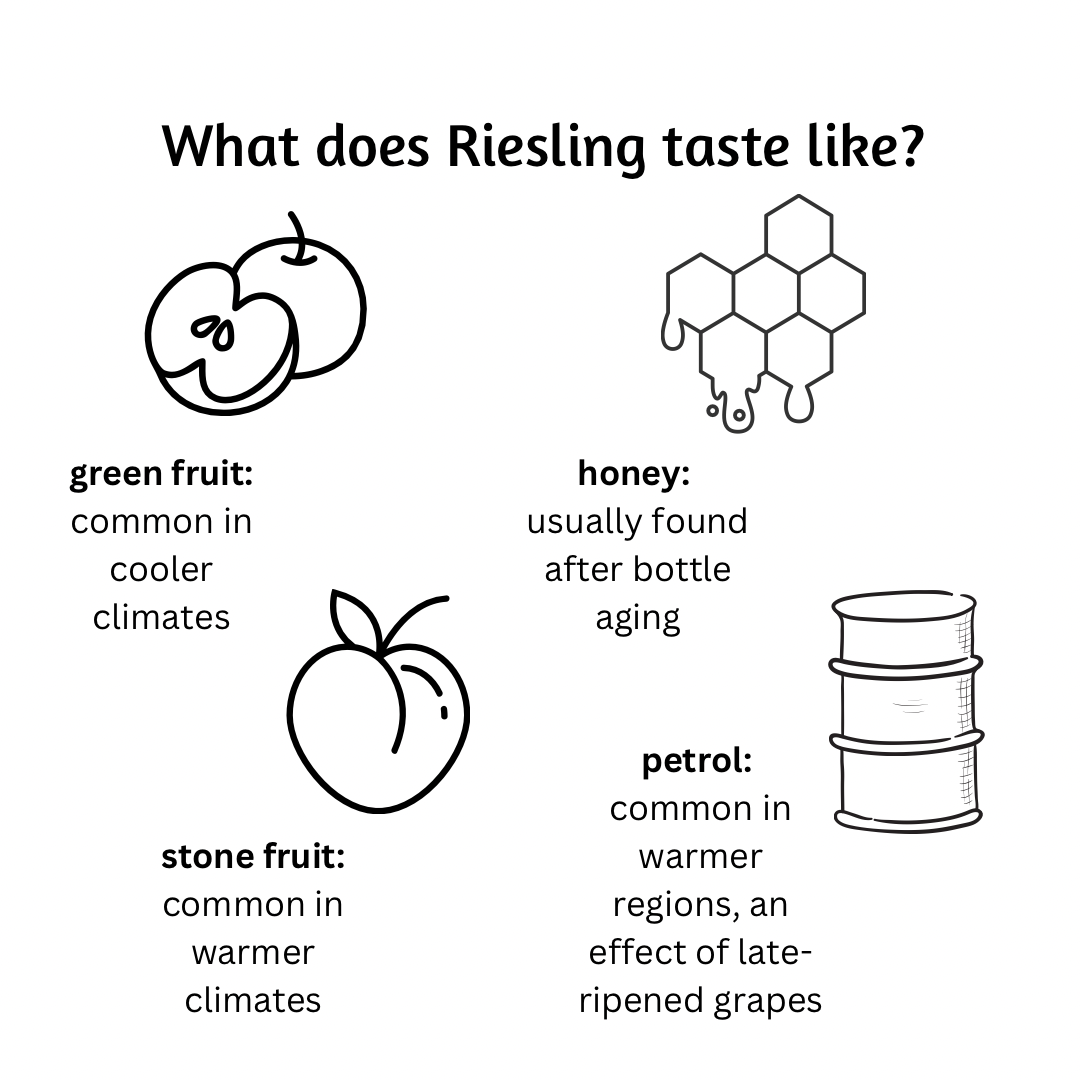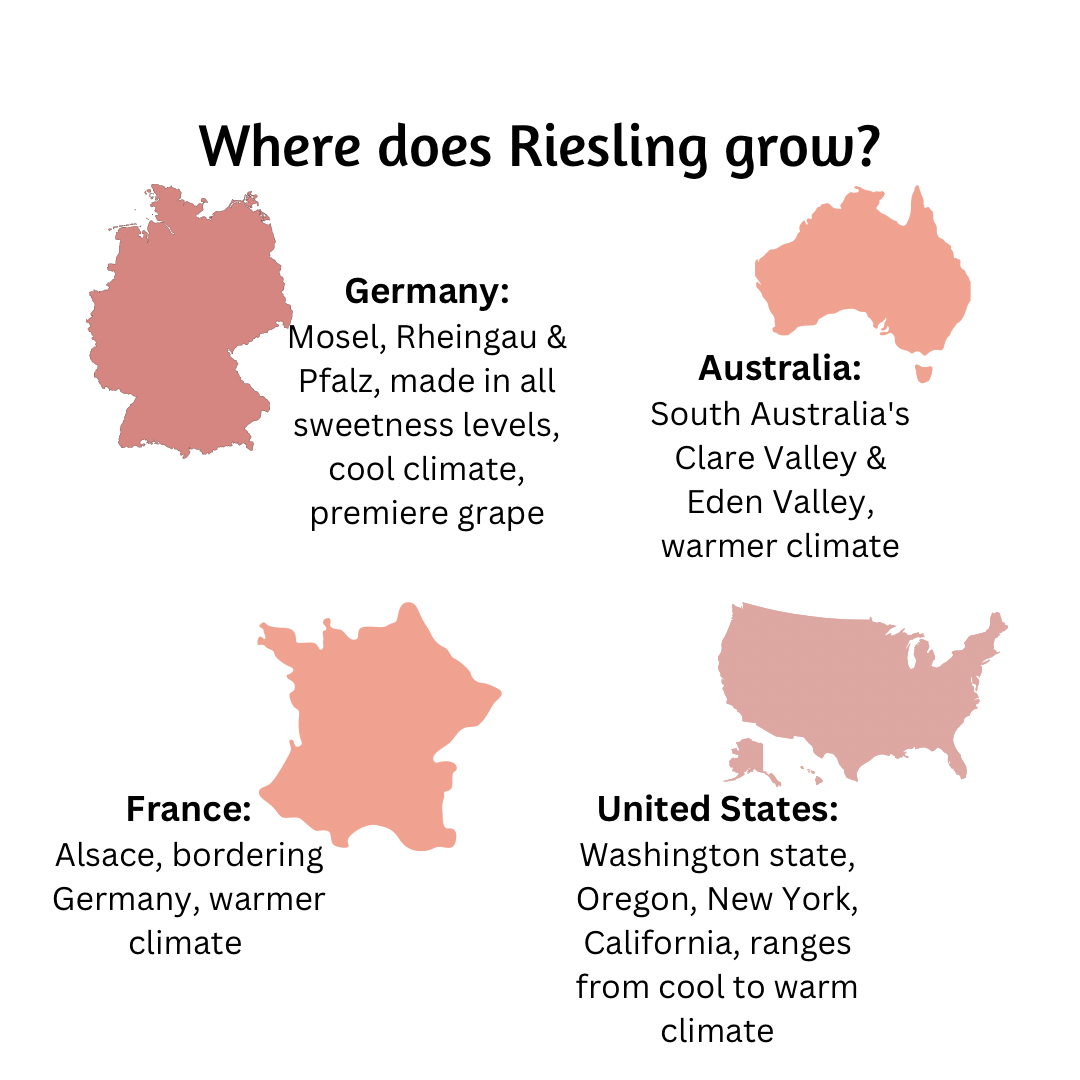Welcome to my quick guide on everything you NEED to know about Riesling wine. From characteristics to tasting notes, predominant growing regions, and food pairings, I’ve got you covered!
Riesling is a white wine made primarily in Germany, though it grows around the world. Its versatility makes it a fun wine that’s guaranteed to taste unique every time, depending on where it’s grown and how it’s made.
With flavors ranging from tart and dry to plus and tropical, few wines can pull off the range of flavors, aromas, and textures as Riesling. In fact, it’s one of the few wines where the aroma of gasoline can be taken as a compliment!
What I love about Riesling: It’s one of the most versatile food-pairing wines! I especially love it with seafood. It’s one of my favorite wine pairings for sushi!

Characteristics of Riesling Wine
Riesling is a white wine made primarily in Germany, though it has found success around the world due to its mass appeal and ability to grow in both cool and moderate climates. It is made in every sweetness level, from bone dry to dessert wine.
The flavor of Riesling will depend on if it is grown in a cool or moderate climate and its sweetness level. It’s typically a high acid and light-bodied wine, though the warmer the climate the more subtle the acidity and fuller in body it will appear. Similarly, it is usually low in alcohol (11%-13% ABV), though the warmer the climate the higher in alcohol it will be.
In terms of winemaking, while not typically aged in oak, some winemakers will age the wine in neutral (near flavorless) oak barrels. Skipping the oak aging helps to maintain the natural acidity of the wine and preserve its floral aromas.
As for aging, Riesling typically ages well because of its vibrant acidity which helps to preserve the wine similarly to tannins in red wines. Many examples of Riesling can age anywhere from 1-10 years in bottle.

Riesling Tasting Notes
As mentioned above, the flavor of Riesling will depend on its sweetness and the climate it’s grown in.
Dry and semi-dry Riesling from cool climates (think Germany) will have higher acidity, with flavors ranging from lemon, lime, and green fruit. The sweeter the wine gets, the more you’ll notice flavors of honey, nuts, and flowers.
Moderate climate Riesling (think Washington state) will have less acidity and more body. Flavors of tropical, stone fruit, and floral aromas are common.
Following bottle aging, you can expect Riesling’s signature green fruit and citrus flavors to unravel into layers of honey, nuts, and floral flavors and aromas.

Where is Riesling Wine Made?
Riesling is grown in many wine regions because of its mass appeal and diversity in flavor. That said, it’s most notably found in Germany, France, the United States, and Australia.
Germany
The most prestigious region for Riesling, made in all sweetness levels. Expect delicious, age-worthy wines from Germany’s three premiere wine regions: Mosel, Rheingau, and Pfalz.
Mosel – Cool climate, light-bodied, high acid, made in all sweetness levels. Aromas of petrol and flavors of minerality, lemon, blossoms, and peaches.
Rheingau – Slightly warmer climate, medium-body, mild acid, made in all sweetness levels. Expect flavors of stone fruit, lime, honey, and tropical fruit.
Pfalz – Borders the Alsace region of France and is the warmest of the three. Wines here are medium in body with mild acidity. Expect flavors of ginger, lime, grapefruit, and subtle notes of pepper.
France
Alsace – Riesling here is similar to the ones in Germany in terms of vibrant acidity, expressive aromas, and age-ability. Expect flavors of apricot, peach, green apple, and honey.
United States (Washington, Oregon & New York)
Riesling is made throughout the United States, though it’s found the most success in Washington state, Oregon, and New York.
Washington – Warmer climate makes for medium-bodied Riesling with higher alcohol, made mostly in dry to semi-sweet styles. Expect flavors of peach, grapefruit, honey, and green pear.
Oregon – Cooler climate makes for naturally high-acid Riesling made in dry and off-dry styles. Expect flavors of green apple, citrus zest, and apricot.
New York – Arguably the best examples of U.S. Riesling come from the Finger Lakes. This cooler climate makes for wines in dry or off-dry styles. Expect minerality with flavors of orange blossoms, nectarine, lemon, and grapefruit.
Australia
Riesling is grown throughout Australia, though it’s found the most success in Southern Australia’s Eden Valley and Clare Valley. These warmer climates make for wines with medium body, high alcohol, and structured acidity. Expect flavors of lime zest, apricot, grapefruit, white flower, and tropical fruit.
Label terms to know
| Term | Meaning |
| Dry | No residual sugar |
| Off-dry | Small amount of detectible sugar |
| Late-harvest | Grapes harvested later in the year with more concentrated sugar levels |
| Spätlese | German late-harvested wines |
| Auslese | German “select harvest” meaning the grapes were hand-picked from very ripe bunches, making for sweet wines |
| Kabinett | German term for dry or off-dry wines |
Curious about how sugar affects wine? check out my latest post on sugar in wine– it’s not what it looks like!

Riesling Food Pairings
Riesling is one of the best wines for food pairing because of its versatility and varying levels of sweetness. Its racy acidity, fresh flavor, and vibrant aroma make it ideal for pairing with everything from seafood to chicken to more tricky cuisines such as Indian food or Thai food.
The sweeter the wine, the better it is to be paired with spicy dishes. That said, keep in mind the wine should always be sweeter than the food, so avoid pairing semi-sweet Riesling with desserts. To learn more about pairing wine with food, check out my beginner’s guide!
Food pairings for dry or off-dry Riesling:
- Lean proteins- chicken cooked in cream sauces or herbs
- Seafood- ceviche, fresh oysters, scallops, clams
- Lemon dishes- chicken piccata, shrimp scampi
- Stinky cheeses- camembert, brie, limburger
Off-dry or semi-sweet Riesling:
- Spicy foods- curry, Asian stir fry, Sichuan chicken
- Salty cheeses- gorgonzola, feta, parmesan
- Proteins with fruit components- Pork chops with applesauce, citrus roasted chicken, salmon with cherry glaze
Sweet Riesling:
- Citrus desserts- lemon cookies, lemon meringue, orange olive oil cake
- Salty cheeses
- Fresh or stewed fruit with whipped cream
Wines like Riesling
- Pinot Grigio- medium acidity, green fruit, and citrus flavors
- Sauvignon Blanc- high acidity, citrus, and vibrancy of aroma
- Gewürztraminer- made dry-sweet, aromatic, similar growing regions
Want to learn more about wine?
I can not recommend The Wine Bible by Karen MacNeil enough. To date, I consistently refer to this book when creating content for myself and my clients. It’s reliable, easy to read, and remarkably well-written.


Comments are closed.